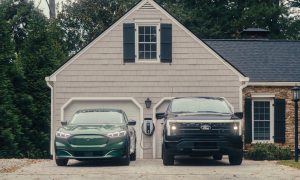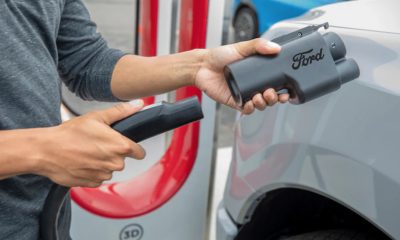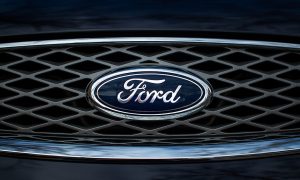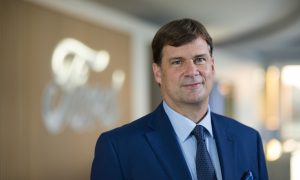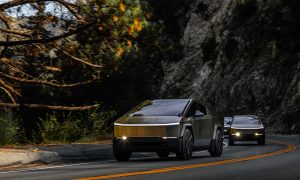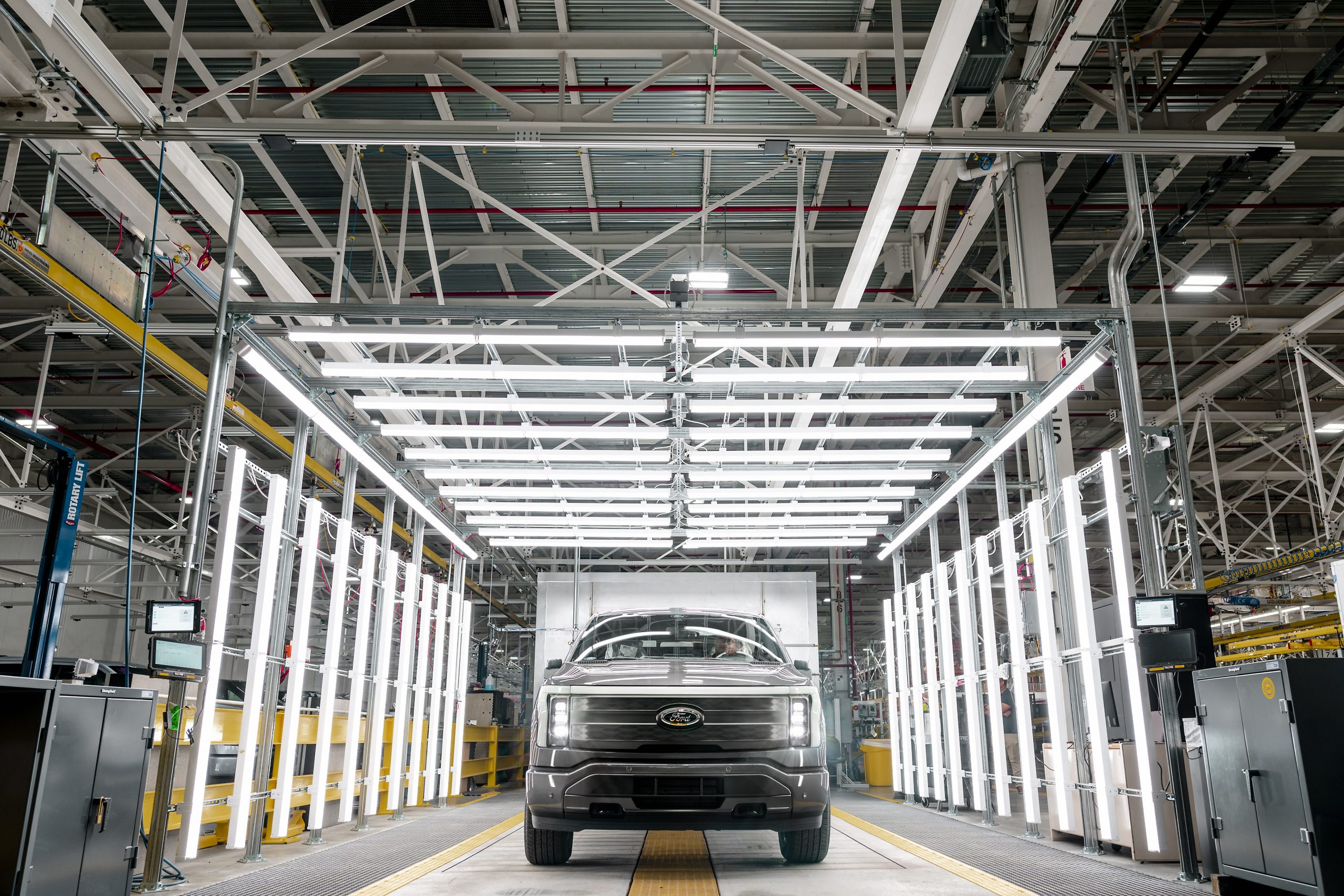

News
Ford’s top brass sit down with Sandy Munro to discuss the F-150 Lightning
Ford CEO Jim Farley and other company executives were interviewed by Sandy Munro earlier this week, highlighting the work done on the F-150 Lightning, its defining features, as well as Ford’s future more generally.
Sandy Munro of Munro Associates runs a YouTube channel where he and his team dive into different models of vehicles and analyze their dependability, durability, and overall engineering design work. However, Sandy and fellow Munro associate Cory Steuben got to sit down with top leaders from Ford, which included Farley, Linda Zhang, who was the Chief Engineer of the all-electric pickup, and Doug Field, the automaker’s Chief Officer of EVs. Mainly focusing on the F-150 Lightning but also talking about the brand’s future and competitors, the interview culminated as Sandy asked the executive team about possible vertical integration within their manufacturing process, possible partnerships with Tesla, and a possible switch to the Tesla connector as the US default.
The video starts with Sandy getting the keys to his new F-150 Lightning, kindly delivered in person by Jim Farley and the team. However, Sandy quickly moves to ask about the truck and its design.
While Sandy was quick to praise the EV drivetrain and the durability of design, foremost thought the interview; the executive team focused on accessory features instead. Doug Field specifically sees the onboard generator, the large frunk, and the bi-directional power (the feature that allows the truck to power the home during a blackout) as the top reasons consumers have flocked to the new truck. Farley continues by noting that, while he didn’t expect the vehicle’s features to be such a crowd pleaser, he believes that they are the reason consumers aren’t asking “why an EV,” but “why not!”
The rest of the interview generally focuses on the market and the Ford brand. The biggest question is the thought of exponential growth in the EV market. Sandy notes explicitly that the US market had recently reached a 5% market share of EVs, what he calls a “tipping point” in the market. Jim responds positively, noting that he is excited about the chance to expand so quickly, expanding older plants such as “The Rouge” and constructing new plants like their new facility in Tennessee to meet demand. Further, he notes he isn’t worried about the brand’s ability to meet demand.
Another big question on the mind of Sandy (and many others who are interested in EVs) is the question of a partnership with Tesla, as well as the executives’ thoughts on the recent proposal to make the Tesla connector the new US standard. “We consider everything,” Doug responds tritely. The team responds to a Tesla partnership, saying that Ford would need a powerful motivating idea to consider abandoning their independence and partnering with another maker, Tesla or otherwise. However, none of the team concretely answered Sandy’s question about standardizing the Tesla Connector.
The group next addresses the possibility of increased verticle integration within their manufacturing. Software, batteries, and powertrain parts were essential parts where they stated the brand would likely continue to pursue verticle integration, going as far as to call other battery makers such as CATL “competitors.” However, Farley notes that he would not compromise the user experience in efforts of verticle integration.
Sandy concludes by lamenting the lack of the $20-$25,000 EV. He mentions that the in-demand Maverick is an excellent example of a vehicle that shows affordable vehicles can still do well and prove profitable for brands like Ford. Doug responds conservatively that, while they see the segment as “very important for global competitiveness,” difficulties remain in acquiring affordable powertrain parts and batteries. And while LFP batteries may offer an avenue into that market, Ford is still in the process of “considering other options.”
Sandy’s interview shows that Ford remains quite dedicated to pursuing EV tech and why they remain ahead of previous rivals such as GM and the Chrysler family of brands. Farley is thinking ahead of many of these other legacy brands, and despite the hurdles that come with that status (cough cough dealerships cough cough), they are positioning themselves well to succeed. Ford’s sales and stock price seem to reflect this.
What do you think of the article? Do you have any comments, questions, or concerns? Shoot me an email at william@teslarati.com. You can also reach me on Twitter @WilliamWritin. If you have news tips, email us at tips@teslarati.com!
News
Tesla UK sales see 14% year-over-year rebound in June: SMMT data
The SMMT stated that Tesla sales grew 14% year-over-year to 7,719 units in June 2025.

Tesla’s sales in the United Kingdom rose in June, climbing 14% year-over-year to 7,719 units, as per data from the Society of Motor Manufacturers and Traders (SMMT). The spike in the company’s sales coincided with the first deliveries of the updated Model Y last month.
Model Y deliveries support Tesla’s UK recovery
Tesla’s June performance marked one of its strongest months in the UK so far this year, with new Model Y deliveries contributing significantly to the company’s momentum.
While the SMMT listed Tesla with 7,719 deliveries in June, independent data from New AutoMotive suggested that the electric vehicle maker registered 7,891 units during the month instead. However, year-to-date figures for Tesla remain 2% down compared to 2024, as per a report from Reuters.
While Tesla made a strong showing in June, rivals are also growing. Chinese automaker BYD saw UK sales rise nearly fourfold to 2,498 units, while Ford posted the highest EV growth among major automakers, with a more than fourfold increase in the first half of 2025.
Overall, the UK’s battery electric vehicle (BEV) demand surged 39% to to 47,354 units last month, helping push total new car sales in the UK to 191,316 units, up 6.7% from the same period in 2024.
EV adoption accelerates, but concerns linger
June marked the best month for UK car sales since 2019, though the SMMT cautioned that growth in the electric vehicle sector remains heavily dependent on discounting and support programs. Still, one in four new vehicle buyers in June chose a battery electric vehicle.
SMMT Chief Executive Mike Hawes noted that despite strong BEV demand, sales levels are still below regulatory targets. “Further growth in sales, and the sector will rely on increased and improved charging facilities to boost mainstream electric vehicle adoption,” Hawes stated.
Also taking effect this week was a new US-UK trade deal, which lowers tariffs on UK car exports to the United States from 27.5% to 10%. The agreement could benefit UK-based EV producers aiming to expand across the country.
News
Tesla Model 3 ranks as the safest new car in Europe for 2025, per Euro NCAP tests
Despite being on the market longer than many of its rivals, the Tesla Model 3 continues to set the bar for vehicle safety.

The Tesla Model 3 has been named the safest new car on sale in 2025, according to the latest results from the Euro NCAP. Among 20 newly tested vehicles, the Model 3 emerged at the top of the list, scoring an impressive 359 out of 400 possible points across all major safety categories.
Tesla Model 3’s safety systems
Despite being on the market longer than many of its rivals, the Tesla Model 3 continues to set the bar for vehicle safety. Under Euro NCAP’s stricter 2025 testing protocols, the electric sedan earned 90% for adult occupant protection, 93% for child occupant protection, 89% for pedestrian protection, and 87% for its Safety Assist systems.
The updated Model 3 received particular praise for its advanced driver assistance features, including Tesla’s autonomous emergency braking (AEB) system, which performed well across various test scenarios. Its Intelligent Speed Assistance and child presence detection system were cited as noteworthy features as well, as per a WhatCar report.
Other notable safety features include the Model 3’s pedestrian-friendly pop-up hood and robust crash protection for both front and side collisions. Euro NCAP also highlighted the Model 3’s ability to detect vulnerable road users during complex maneuvers, such as turning across oncoming traffic.
Euro NCAP’s Autopilot caution
While the Model 3’s safety scores were impressive across the board, Euro NCAP did raise concerns about driver expectations of Tesla’s Autopilot system. The organization warned that some owners may overestimate the system’s capabilities, potentially leading to misuse or inattention behind the wheel. Even so, the Model 3 remained the highest-scoring vehicle tested under Euro NCAP’s updated criteria this year.
The Euro NCAP’s concerns are also quite interesting because Tesla’s Full Self-Driving (FSD) Supervised, which is arguably the company’s most robust safety suite, is not allowed for public rollout in Europe yet. FSD Supervised would allow the Model 3 to navigate inner city streets with only minimal human supervision.
Other top scorers included the Volkswagen ID.7, Polestar 3, and Geely EX5, but none matched the Model 3’s total score or consistency across categories. A total of 14 out of 20 newly tested cars earned five stars, while several models, including the Kia EV3, MG ZS, and Renault 5, fell short of the top rating.
Elon Musk
Why Tesla’s Q3 could be one of its biggest quarters in history
Tesla could stand to benefit from the removal of the $7,500 EV tax credit at the end of Q3.

Tesla has gotten off to a slow start in 2025, as the first half of the year has not been one to remember from a delivery perspective.
However, Q3 could end up being one of the best the company has had in history, with the United States potentially being a major contributor to what might reverse a slow start to the year.
Earlier today, the United States’ House of Representatives officially passed President Trump’s “Big Beautiful Bill,” after it made its way through the Senate earlier this week. The bill will head to President Trump, as he looks to sign it before his July 4 deadline.
The Bill will effectively bring closure to the $7,500 EV tax credit, which will end on September 30, 2025. This means, over the next three months in the United States, those who are looking to buy an EV will have their last chance to take advantage of the credit. EVs will then be, for most people, $7,500 more expensive, in essence.
The tax credit is available to any single filer who makes under $150,000 per year, $225,000 a year to a head of household, and $300,000 to couples filing jointly.
Ending the tax credit was expected with the Trump administration, as his policies have leaned significantly toward reliance on fossil fuels, ending what he calls an “EV mandate.” He has used this phrase several times in disagreements with Tesla CEO Elon Musk.
Nevertheless, those who have been on the fence about buying a Tesla, or any EV, for that matter, will have some decisions to make in the next three months. While all companies will stand to benefit from this time crunch, Tesla could be the true winner because of its sheer volume.
If things are done correctly, meaning if Tesla can also offer incentives like 0% APR, special pricing on leasing or financing, or other advantages (like free Red, White, and Blue for a short period of time in celebration of Independence Day), it could see some real volume in sales this quarter.
You can now buy a Tesla in Red, White, and Blue for free until July 14 https://t.co/iAwhaRFOH0
— TESLARATI (@Teslarati) July 3, 2025
Tesla is just a shade under 721,000 deliveries for the year, so it’s on pace for roughly 1.4 million for 2025. This would be a decrease from the 1.8 million cars it delivered in each of the last two years. Traditionally, the second half of the year has produced Tesla’s strongest quarters. Its top three quarters in terms of deliveries are Q4 2024 with 495,570 vehicles, Q4 2023 with 484,507 vehicles, and Q3 2024 with 462,890 vehicles.
-

 Elon Musk4 days ago
Elon Musk4 days agoTesla investors will be shocked by Jim Cramer’s latest assessment
-

 News1 week ago
News1 week agoTesla Robotaxi’s biggest challenge seems to be this one thing
-

 Elon Musk2 weeks ago
Elon Musk2 weeks agoFirst Look at Tesla’s Robotaxi App: features, design, and more
-

 News2 weeks ago
News2 weeks agoSpaceX and Elon Musk share insights on Starship Ship 36’s RUD
-

 News2 weeks ago
News2 weeks agoWatch Tesla’s first driverless public Robotaxi rides in Texas
-

 News1 week ago
News1 week agoWatch the first true Tesla Robotaxi intervention by safety monitor
-

 News2 weeks ago
News2 weeks agoTesla has started rolling out initial round of Robotaxi invites
-

 Elon Musk2 weeks ago
Elon Musk2 weeks agoTesla to launch in India in July with vehicles already arriving: report




